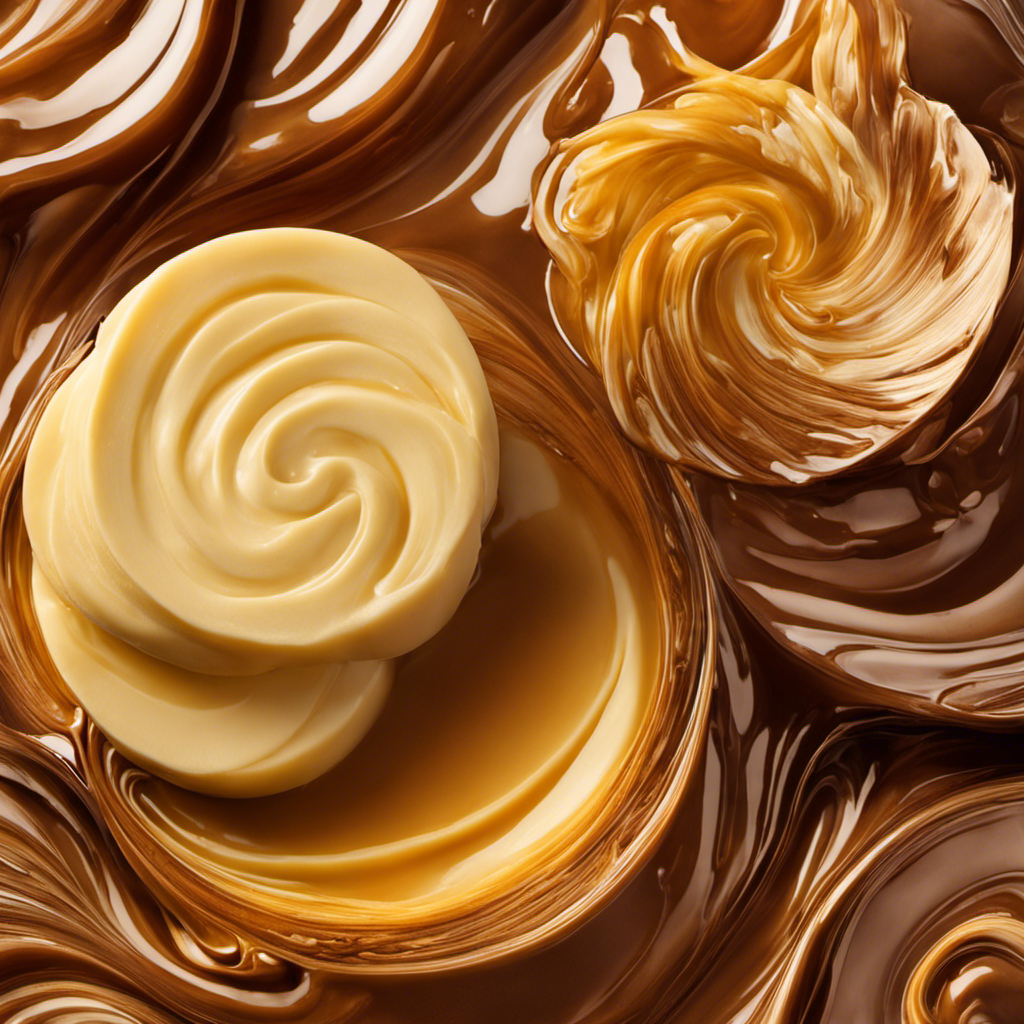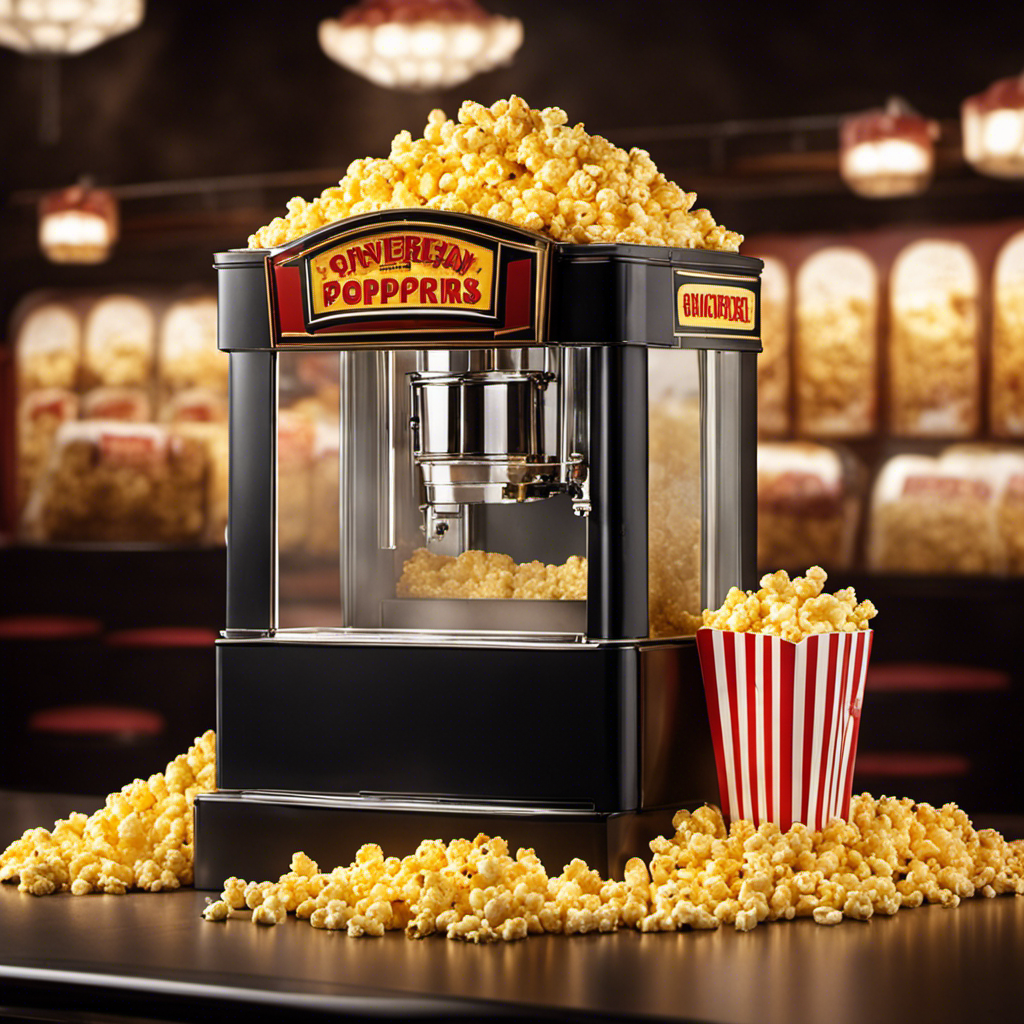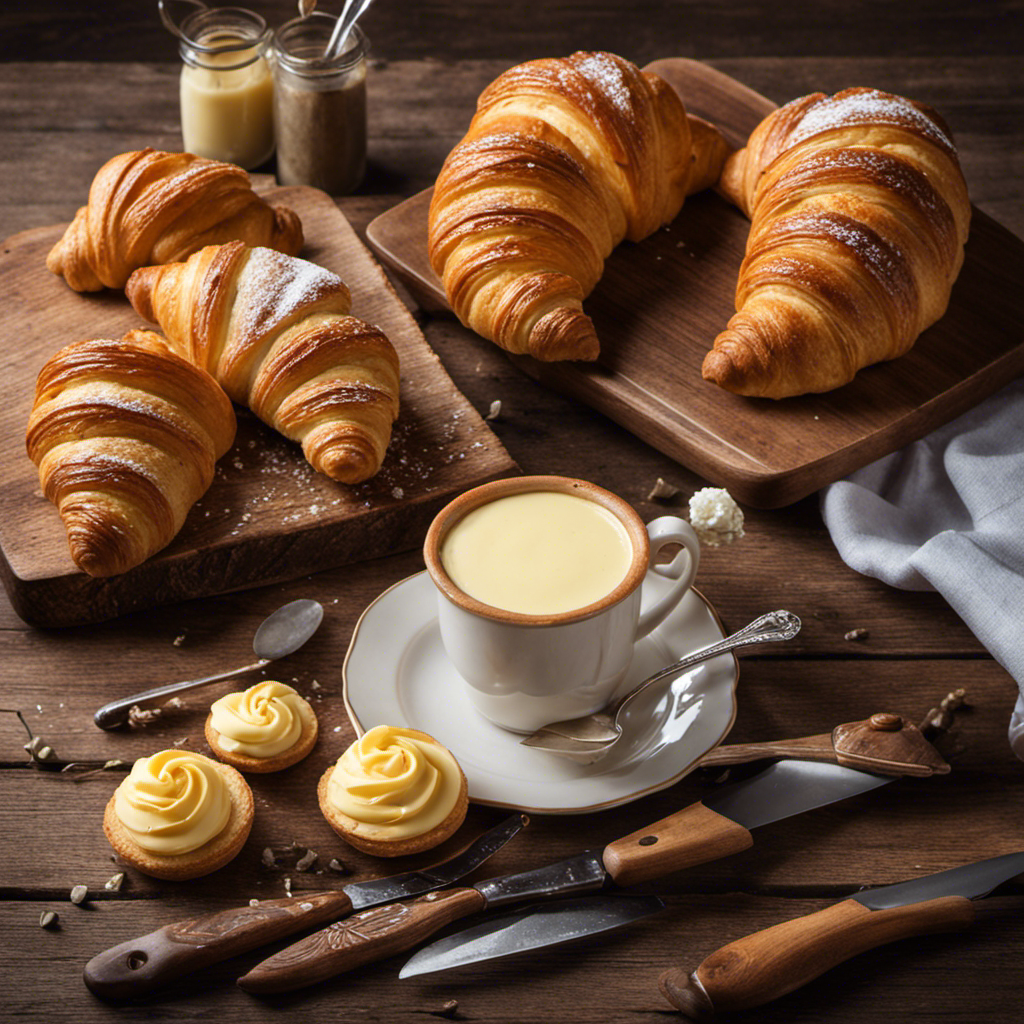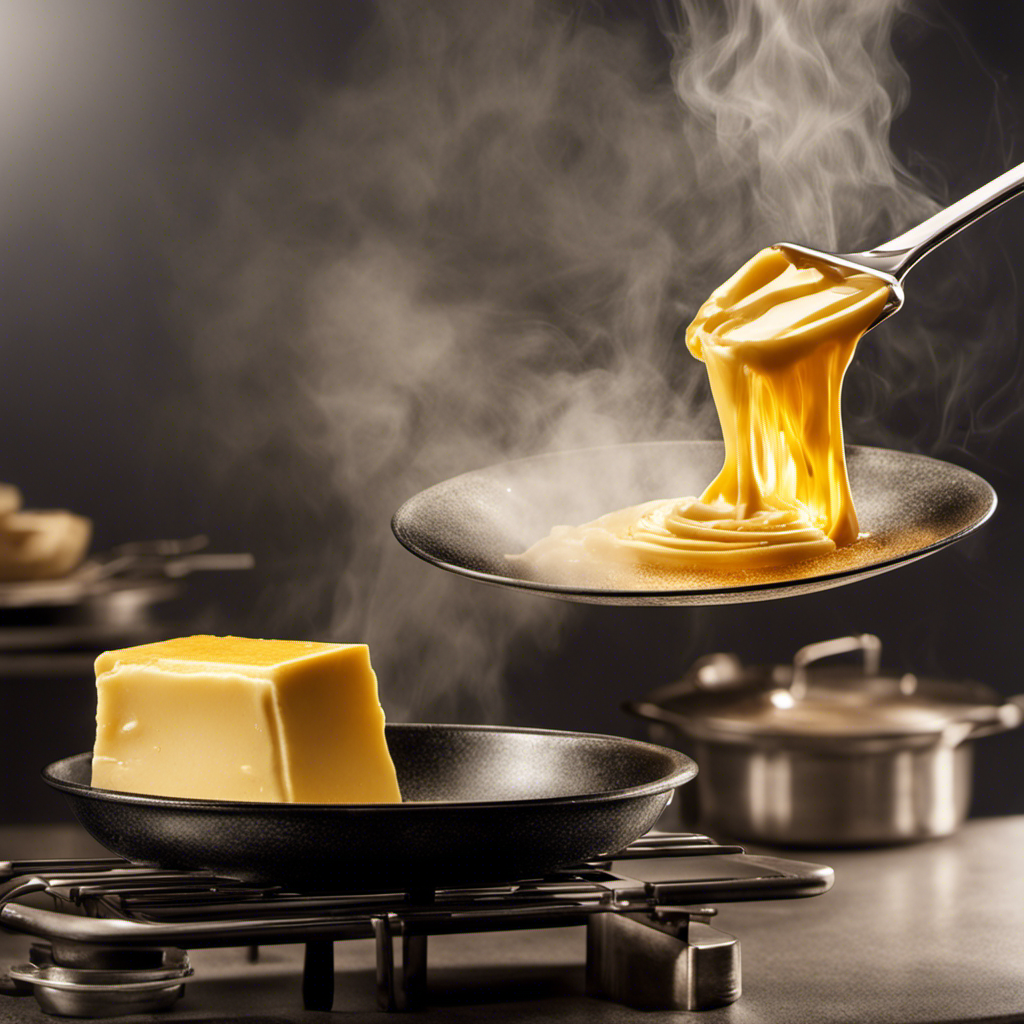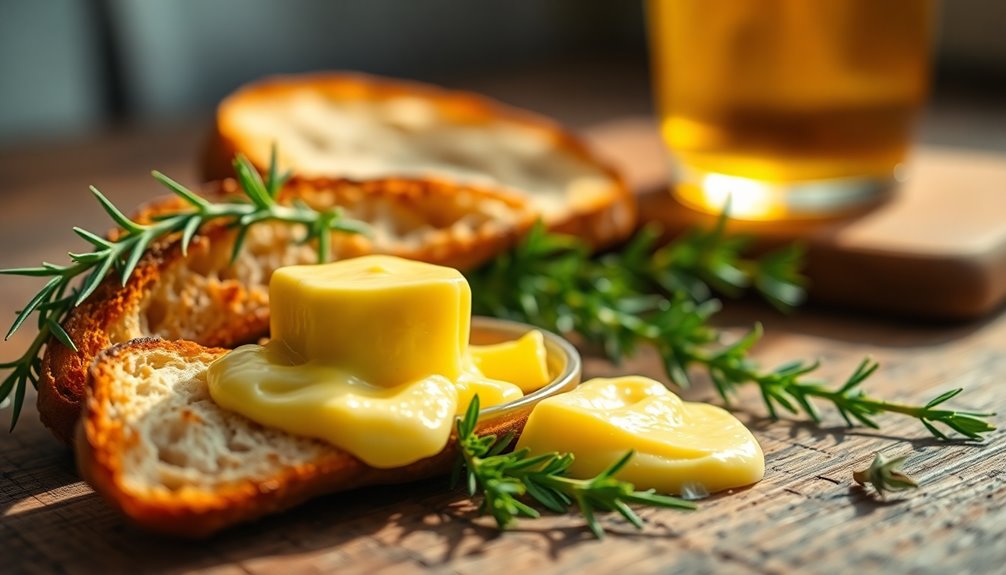The adage that patience is a virtue truly applies when it comes to brown butter.
It’s a culinary delight that adds a depth of flavor to any dish.
Picture this: a warm, nutty aroma filling your kitchen as butter slowly transforms into a rich, caramelized elixir.
The taste? Nothing short of heavenly.
With its creamy texture and ability to enhance a multitude of recipes, brown butter is a true kitchen superstar.
So, what does it taste like? Let’s dive in and find out.
Key Takeaways
- Brown butter has a nutty and aromatic flavor, with a captivating toasted hazelnut aroma.
- It adds rich and caramelized notes to dishes, with a complex taste that includes hints of toasted nuts and subtle sweetness.
- Brown butter enhances and deepens flavors in recipes, infusing them with a rich and savory taste.
- It creates a creamy and velvety texture, coating the taste buds with a luscious mouthfeel and adding richness and depth to dishes.
Nutty and Aromatic Flavors
When you cook butter for a longer period of time, it becomes brown and develops a nutty and aromatic flavor. The transformation is truly remarkable.
As the butter melts and begins to foam, the color gradually changes to a beautiful golden brown. The scent fills the air, releasing a captivating toasted hazelnut aroma that is undeniably enticing. The buttery aroma is rich and alluring, drawing you in with its warm and comforting notes. It’s as if the butter is whispering promises of deliciousness.
This toasted hazelnut flavor adds depth and complexity to any dish it is used in, elevating the taste to a whole new level. And it’s only the beginning of the journey into the world of brown butter’s rich and caramelized notes.
Rich and Caramelized Notes
You’ll love the rich and caramelized notes of brown butter. When butter is heated, the milk solids begin to separate and undergo a process called caramelization. This process is what gives brown butter its distinctive flavor and aroma.
As the butter cooks, the milk solids turn golden brown, releasing a nutty fragrance that fills the kitchen. The caramelization process also creates a depth of flavor that is unparalleled. The taste of brown butter is complex, with hints of toasted nuts and a subtle sweetness.
It adds a luxurious touch to both sweet and savory dishes, elevating everything from cookies and cakes to pasta and vegetables. The flavor development that occurs during the caramelization process is truly magical, making brown butter a beloved ingredient in the culinary world.
Enhancing and Deepening Flavors
To enhance and deepen flavors, try incorporating brown butter into your favorite recipes. Brown butter, also known as beurre noisette, is a culinary gem that adds a nutty and toasty aroma to any dish.
Here are some cooking techniques for maximizing flavor depth and pairing brown butter with different ingredients to create complex tastes:
-
Cooking techniques:
-
Sautéing: Brown butter makes a perfect base for sautéing vegetables or searing meats, infusing them with a rich and savory flavor.
-
Baking: Incorporating brown butter into cakes, cookies, or pastries adds a delightful caramelized undertone and a heightened sense of indulgence.
-
Pairing ingredients:
-
Vegetables: Drizzle brown butter over roasted Brussels sprouts or sautéed mushrooms for a deliciously earthy combination.
-
Seafood: Pan-fry fish or scallops in brown butter to enhance their natural sweetness and bring out their delicate flavors.
By incorporating brown butter into your cooking repertoire, you’ll elevate your dishes to new heights of flavor complexity.
And speaking of elevating flavors, let’s explore how brown butter can also contribute to a creamy and velvety texture.
Creamy and Velvety Texture
Incorporating brown butter into your recipes creates a creamy and velvety texture that adds a luxurious element to your dishes. When butter is heated until the milk solids brown, it develops a nutty aroma and deepens in flavor. This transformation also affects its texture, resulting in a smooth consistency that coats your taste buds with a luscious mouthfeel.
The creamy texture of brown butter can elevate a simple dish, turning it into something truly special. It adds richness and depth, making every bite a delight for your senses. Whether you’re drizzling it over roasted vegetables or using it in baking, brown butter brings a unique and decadent touch to any recipe.
Its versatility and adaptability make it an essential ingredient for both sweet and savory dishes.
Versatile and Adaptable in Various Recipes
Brown butter’s versatility and adaptability in various recipes make it an essential ingredient for both novice and experienced cooks alike. Its rich and nutty flavor adds depth and complexity to a wide range of dishes, transforming ordinary meals into extraordinary culinary experiences.
Here are a few ways brown butter can adapt to different cuisines and elevate your cooking:
-
In Italian cuisine:
-
Toss it with pasta for a simple yet indulgent dish.
-
Drizzle it over risotto to enhance its creamy texture.
-
In French cuisine:
-
Use it as a base for sauces like beurre blanc or hollandaise.
-
Incorporate it into pastry dough for a delicate buttery flavor.
Brown butter’s ability to adapt to different cuisines allows it to enhance the flavors of various dishes, taking them to new heights. Whether you’re cooking Italian pasta, French pastries, or any other cuisine, brown butter is the secret ingredient that can elevate your culinary creations.
Frequently Asked Questions
How Can I Incorporate Brown Butter Into Savory Dishes?
To incorporate brown butter into savory dishes, try making brown butter infused pasta dishes. The nutty and toasty flavor of brown butter pairs well with pasta. Another option is to drizzle it over roasted vegetables for an extra depth of flavor.
Can I Substitute Brown Butter for Regular Butter in Baking Recipes?
Yes, you can substitute brown butter for regular butter in baking recipes. It adds a nutty, caramelized flavor that enhances the taste of your baked goods. The benefits of using brown butter in recipes are its rich, unique taste and added depth of flavor.
Is There a Difference Between Brown Butter and Clarified Butter?
When it comes to butter, there’s a difference between browning and clarifying. Browning butter adds a nutty flavor and aroma, while clarifying butter removes the milk solids. To clarify butter properly, melt it and skim off the foam.
Does Brown Butter Have a Longer Shelf Life Than Regular Butter?
Brown butter does not have a longer shelf life than regular butter. However, its nutty, caramelized flavor adds depth to savory dishes. Incorporating brown butter into recipes can elevate the taste and bring a rich, aromatic element to your cooking.
Can I Use Brown Butter as a Spread on Toast or Bread?
Yes, brown butter can be used as a delicious spread on toast or bread. It adds a nutty, rich flavor that pairs well with both sweet and savory toppings. Try it with honey or cinnamon for a tasty twist!
Conclusion
In conclusion, once you experience the delectable delight of brown butter, you’ll find yourself transported to a world of nutty splendor and aromatic bliss. Its rich and caramelized notes will dance on your taste buds, leaving you craving more.
This versatile ingredient has the power to enhance and deepen flavors, making every dish a culinary masterpiece. And let’s not forget about its creamy and velvety texture, which adds a touch of luxury to any recipe.
So go ahead, indulge in the wonders of brown butter and elevate your cooking to new heights. You won’t be disappointed.
